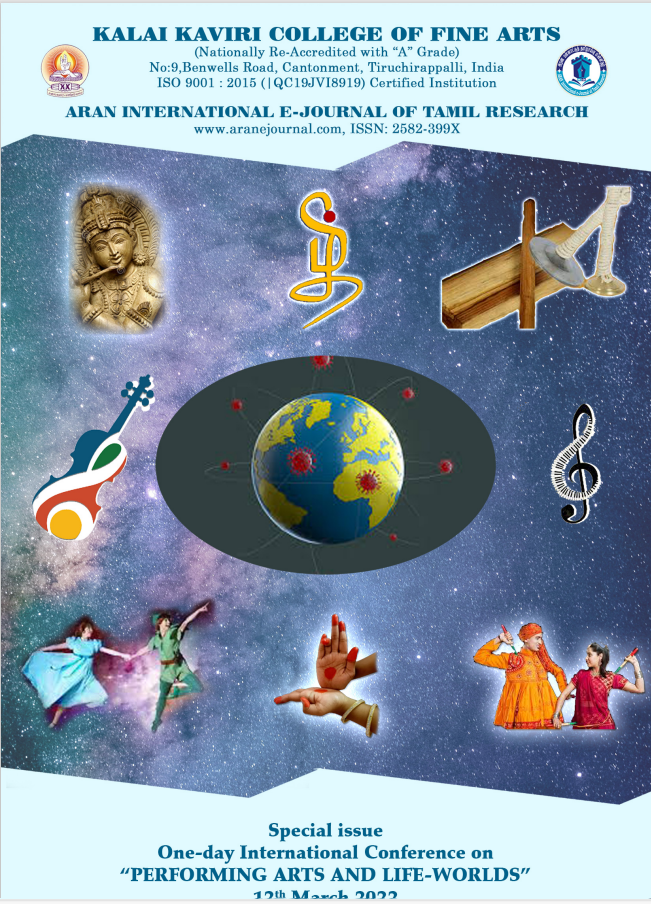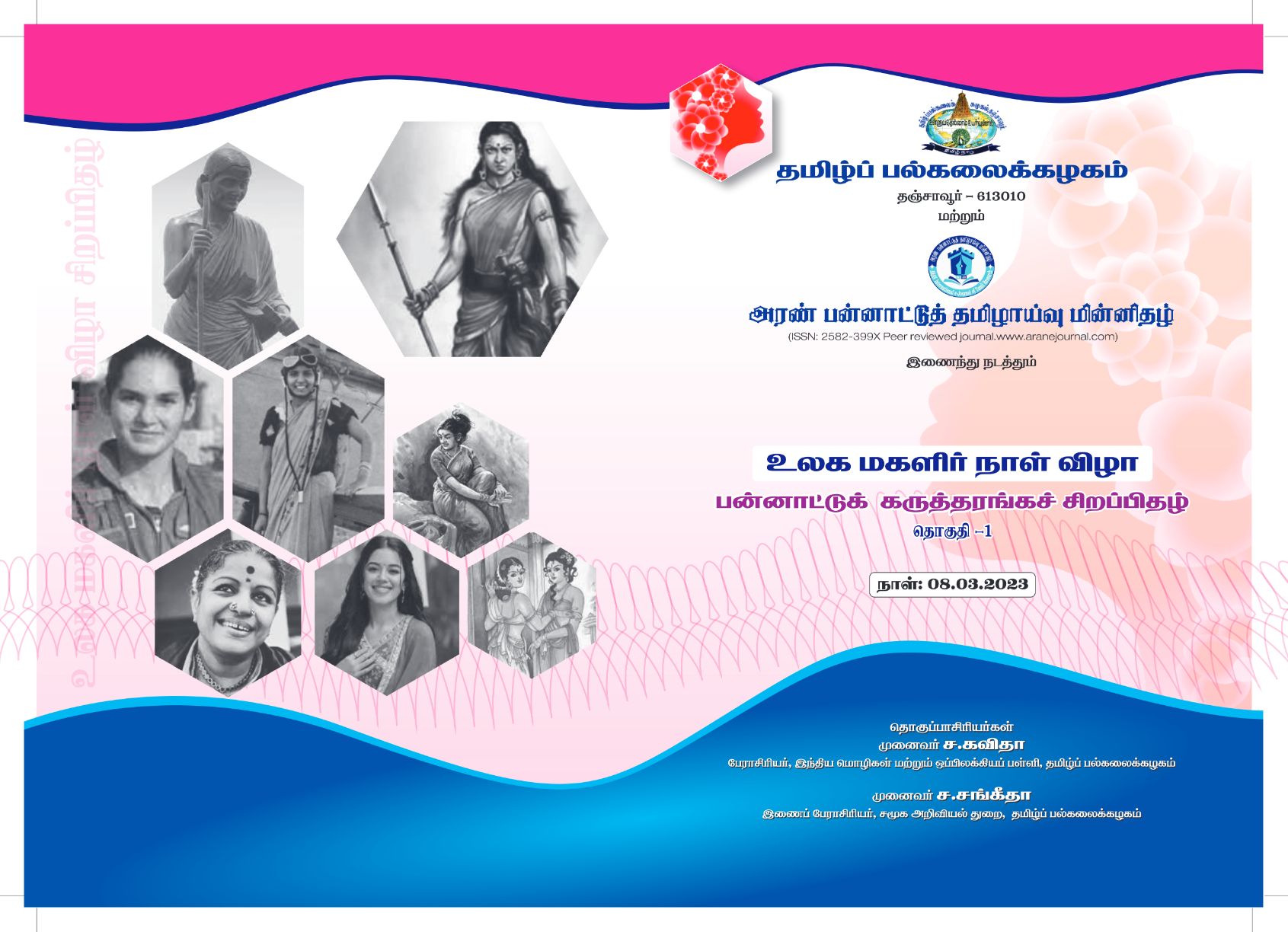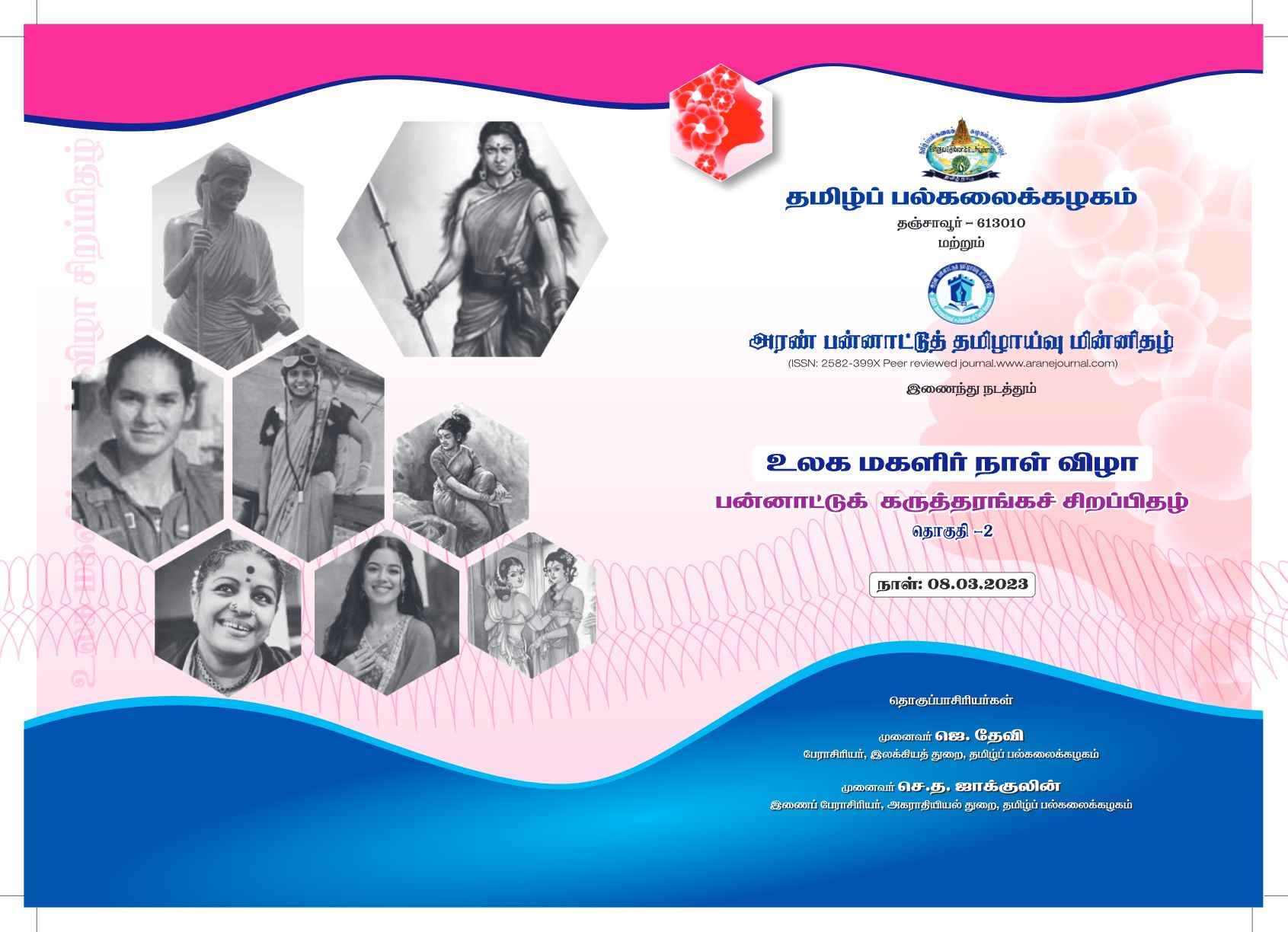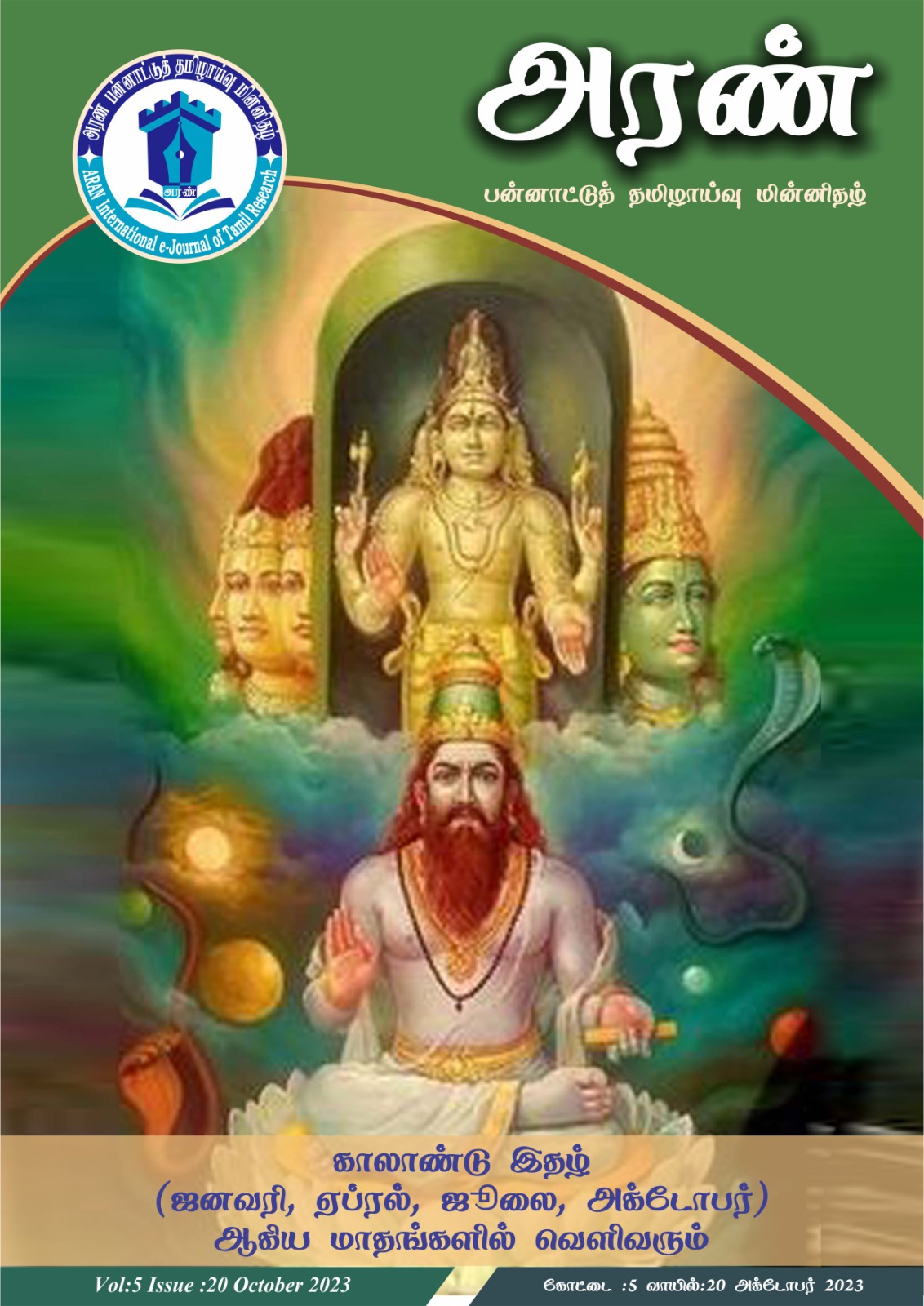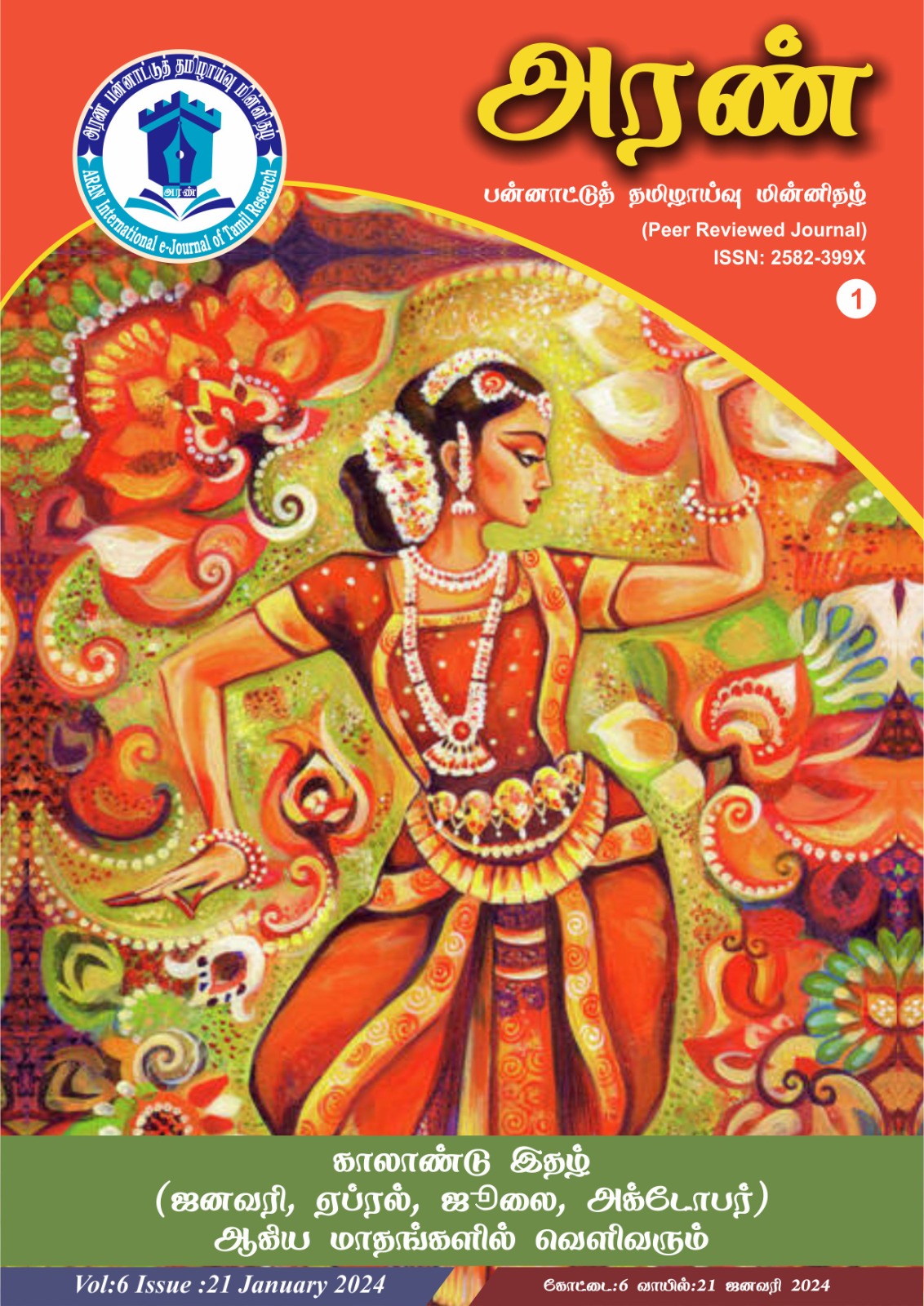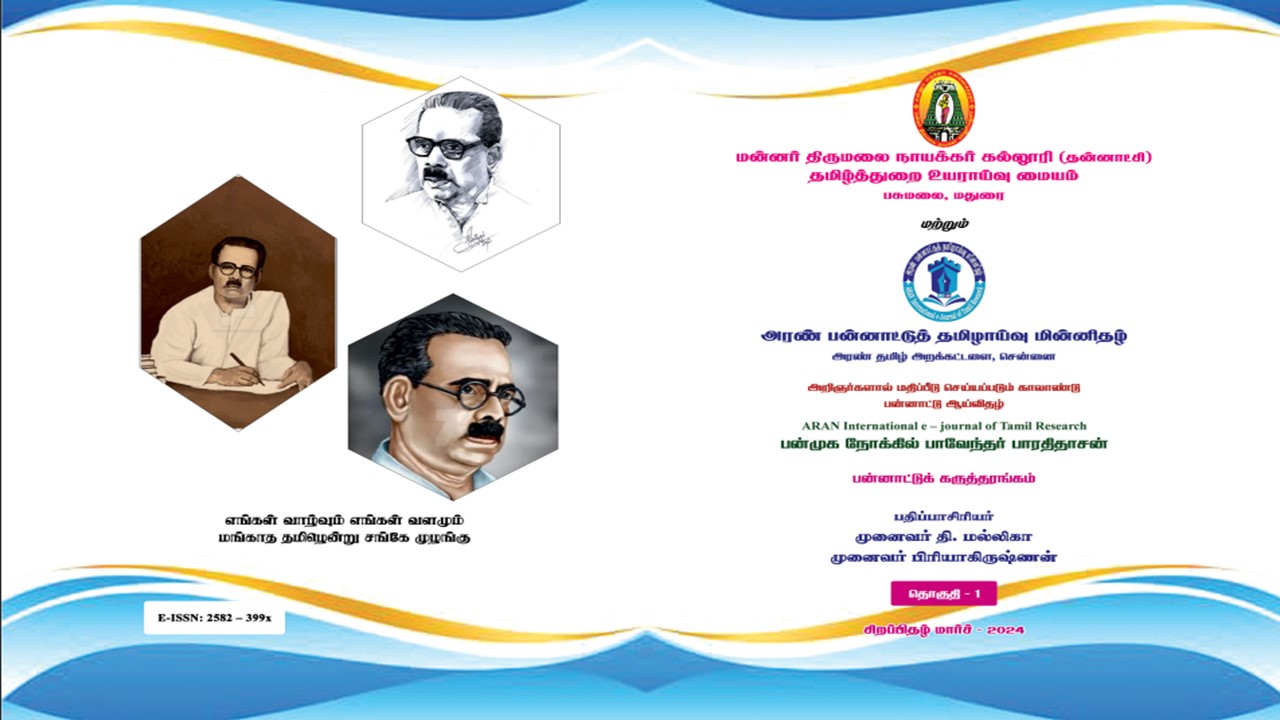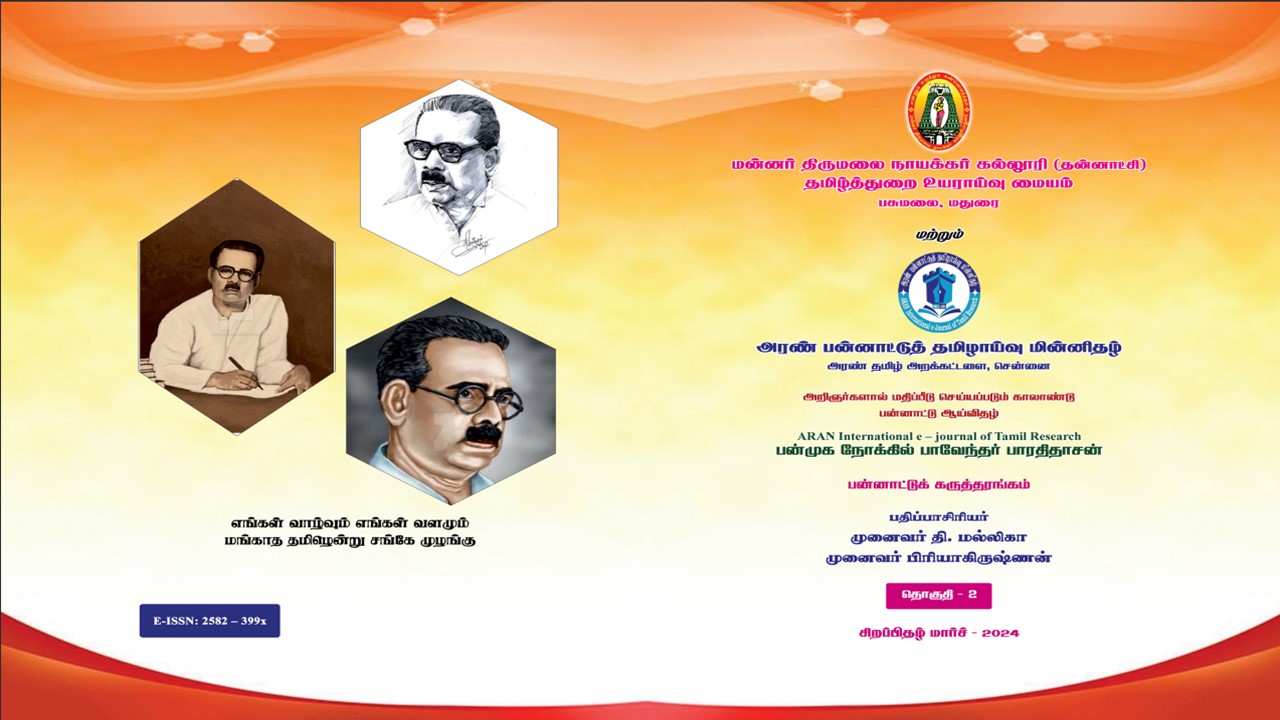Just Another Film Industry: Tamil Cinema in Global India
Author :Miss.Amrutha Kanapulli,
PhD (in Progress),
Michgan State University,
East Lansing
MI- 48824
USA
Abstract: Tamil cinema in the twenty first century is marked by its twin desire to cater to an all-Indian audience, as well as to find visibility on the world cinema festival circuit. Both categories – the nation-state and the world – were integral facets of Tamil cinema’s history. They were almost always the “other,” the “outside,” and are thus met with similar means of engagement by twenty first century Tamil cinema filmmakers. This paper, through a detailing of three key events of Tamil Nadu and Tamil culture seeks to elucidate the differences and contiguities between the terms local, national, and global as they are represented in post-millennial Tamil cinema.
Keywords: Tamil cinema, world cinema, national cinema, #dravidanadu, Bollywood
If Hindi cinema, during the 1940s and the 1950s, had the dominant but often discreet agendas of resisting the British Rule and supporting Gandhi and his Congress Party in their struggle for and entrenchment of India’s freedom/progress, Tamil cinema had its third prerogative of resisting the North Indian/Hindi hegemony. In a collection of essays on Tamil cinema subtitled, “The Cultural Politics of India's Other Film Industry,” Devdas and Velayutham argue that “Tamil cinema has been simultaneously collaborative, complicit and antagonistic to the project of nation building and yet remains at the margins of Indian cinema” (168). While being a fairly accurate summary of the political history of Tamil cinema’s relationship with the nation-state, the statement is one that is growing more complicated with the ever-increasing globality of Chennai city and Tamil Nadu as a whole. It is also being simultaneously reinforced by a continued instability of the Tamil Nadu’s position in the nation-state and the renewed opposition to the majority party at the centre – the extremely right National Democratic Alliance. As such, while Tamil cinema is adapting to global sensibilities, it is at the same time attempting to secure for itself a legitimate place, not in the cinemas from India but in the world cinema arena. To answer the question then of whether Tamil cinema has been catering to a global audience, or marking itself as different from Bollywood through its regional politics, it is simply the case that it is doing both; one does not exclude the other. Given the historically unbalanced relationship with Hindi cinema and the Indian nation-state, it could be argued that for Tamil cinema to pander to a pan-Indian audience is as stark a shift as it would be for the industry to adapt to a global, multiplex-driven audience. And it does so by marking itself as different; whether from Bollywood, Hollywood, or other world cinemas, while still attempting to be recognizable to these diverse audiences.
There are of course exceptions and variations to how Tamil cinema affects itself with a difference from the nation-state. Take for instance the quote from Devdas and Velayutham with which the essay begins. It was written in light of films in the 1990s that engaged with the position of the Tamil subject in India’s nation-building and identity formation. It is in this context that Devdas and Velayutham state that the “figure of the nation is contested through counter narratives which celebrate an essentialized notion of Tamil culture and linguistic identity and which serve to challenge the Hindi centred nationalistic discourses” (156). At the centre of the debates of Tamil cinema’s engagement with the national identity is Mani Ratnam’s highly debated venture, Roja (1992). Ratnam rather definitively engaged with nationhood in this film by focussing it on terrorist infiltration from Pakistan and the central role the Tamil hero plays. That was almost twenty five years ago, in the throes of the Kargil War. His more recent film, Kaatru Veliyidai (Expanse of Wind, 2017), revisits the same war, this time with much greater emphasis on being a national narrative than a Tamil narrative. There is nothing Tamil about either protagonists, almost all major languages find a space in the dialogues, there is no return to a Tamil space and the entire film comes off as a narrative of emotional abuse that just happens to be set in a war zone. There is no essentialized notion of Tamil culture that challenges Hindi centric narratives. Mani Ratnam is then one of those exceptions to the argument that Tamil filmmakers are attempting to construct a sense of a Tamil local in their work. Ratnam most certainly caters to an Indian and global audience. However, it may be because of these choices that it could be argued that Ratnam is losing/ has lost his identity a Tamil director amongst the Tamil audiences. If conscious engagement with the national denies one a Tamil-belonging, then to be quintessentially Tamil, a film may have to deny a wholly “national” belonging.
Contextualizing Tamil (Cinema) in the Nation-State
Tamil identity, as conceived and constructed during the colonial struggle and later in independent India, is rooted in two interrelated ideas: linguistic difference and Dravidian ideology. Being not of the Indo-European tree of languages, Tamil has always sought to differentiate itself from Sanskrit while also elevating itself to the same “classical” status. The government buildings in Tamil Nadu (TN) bear boldly the phrase – “Long live classical divine Tamil!” Tamil literary history claims to go back several thousand years and even lays claim to its own version of the Atlantis myth. It is this linguistic pride that has ceaselessly fuelled an anti-Hindi position that dominates public discourses to this day. At the same time, the idea of an Indian nation-state as forged by struggles against a colonial power was rejected by early Tamil leaders. India as a national culture was perceived to be an Aryan conception and built on principles of caste and religious division, placing Sanskrit and Sanskrit-origin languages such as Hindi at the centre. Since the birth of an independent India, Tamil political leaders demanded secession and the rights to form a Dravidian nation-state or Dravidistan. These notions of non-Indian space as articulated in not-Hindi became driving ideologies of the Dravidian movement and Tamil identity in general, that was propagated by and reinforced through cinema.
The nature of Tamil culture’s relationship with cinema is such that it becomes extremely difficult to articulate a history of modern Tamil identity politics outside the world of cinema. From the beginning of talkies and the resultant showcasing of linguistic differences, Tamil cinema has consciously curated a Tamil identity that is apart from the national agenda. This was the era when cinema and politics began their long-standing love-affair; the late 30s and 40s. By the 1940s, cinema had already set itself on track to become “the most domineering influence in the cultural and political life of Tamil Nadu” (Baskaran xii). The early Tamil political parties – the Dravida Kazhagam, and subsequently the Dravida Munnetra Kazhagam – used cinema extensively as a vehicle for political campaign and social reform. Films such as Nallathambi, Parasakthi (Krishnan & Panju, 1949, 1951), and Velaikaari (Saami, 1949) clearly showcased the principles of the Dravidian party through “narratives highlighting and driven by moral imperatives associated with social ills, family breakdowns, good versus bad, overcoming of social difficulties and subaltern struggles” (Velayutham pg no). This was the DMK era of Tamil cinema, and the time of the most directly political films of the industry.
Tamil cinema of the 1950s-70s, especially the aforementioned examples, was “driven by Dravidian ideology, which challenged the dreams of Nehruvian socialism and progress during the early 1950s, portrayed the apprehensions of the Tamil-speaking world towards the Congress party and North Indian hegemony” (Pillai 7). The symbols of the party and party ideology – the Rising Sun, the spinning wheel etc. – were found aplenty in crucial scenes of films. Speeches and videos of DMK politicians would often be weaved into the screenplay. The plots would typically end in the lead pair coming together in a “self-respect marriage”. Apart from the plots themselves, the dialogues were also influenced by the anti-Brahmin movement. The Brahminical language employed in the earlier films was rejected by the writers of the Dravidian movement, whose dialogues were often heavy with alliterations and used classical, literary Tamil. This served the dual purpose of rejection of Brahminism, while eulogizing the Tamil literary culture (Hardgrave). In essence, Tamil cinema and Tamil cultural politics have had a symbiotic relationship in their early years, constantly feeding into and off each other. This relationship, cemented in such nascent stages, has hardened and continued to influence the politics of Tamil identity well into the twenty first century.
Recent decades of Tamil filmmaking and Tamil cultural politics have witnessed a growing subtlety in the expression of these early sentiments. However, while receding into the space of the subtext, they most certainly have not vanished or been dampened. In fact, one could argue that there are two major phenomena that have brought the ethno-linguistic nature of Tamil cinema back to the fore in the twenty first century: a tendency towards the global, that is matched by a movement away from and as opposed to the national. These tendencies can be exemplified by three events that took place as recent as 2017 that can be read via Tamil cinema not as sudden occurrences, but a cumulative result of gradually evolved relationships between local, national and global.
“We are Tamil!”
Every year in January the Tamil harvest festival, pongal, is celebrated across the state. Given that the harvest is a seasonal phenomenon, the festival is also celebrated in other states but by different names. Unique to the Tamil celebration of the festival however is the bull-taming sport of jallikattu. Jallikattu has been a long-time staple of Tamil culture and is often the site of several events and plot points in real and reel life. It is a common space to showcase masculinity and establish a protagonist’s position in a film. Being quite suited for spectating, it draws large crowds, in the anonymity of which several identities and relationships can be established. It is commonly held along with the village/town fair or the thiruvizha, thus providing ample opportunity for song and dance. Also, it is a uniquely Tamil sport, with no other state patronizing it to the extreme extent TN does.
The pongal of 2017 however was devoid of this entertainment. After a decade-long legal battle between various state, national, and international parties, the Supreme Court of India banned the sport, citing issues of animal cruelty. On the one hand, the TN government was lobbying for the continuing of the annual event. On the other hand, international agencies like PETA and national subsidiaries like the Federation of India Animal Protection Agencies (FIAPA) have been at the forefront of opposing Jallikattu since as long back as 2004. In response to the ban, state-wide protests were held through January 2017, comparable to the anti-Hindi agitations of the 1960s. The DMK party (at this point, the opposition party in the TN) itself played a major part in the protests with their Rail Roko campaign. Meanwhile many instances of jallikattu taking place despite the ban were facilitated – if not actively supported – by the state government.
It is significant that in its judgments, the Supreme Court explicitly evoked a tradition-against-modernity debate by saying that some traditions should be outlawed as they do not fit in with modern civilization, even comparing jallikattu to child marriage (Vaidhyanathan). Jallikattu is also seen as one of the few ways in which local farmers can maintain local breeds of cattle against the onslaught of mechanization and the importation of Jersey breed cows. The jallikattu issue cannot be read but as an explicit and essential difference between the nation, the more cosmopolitan conceptions of animal cruelty, and economic neo-liberalism on one side, and a fundamentally Tamil sensibility along with a need to protect local farmers on the other. Given the prominence of jallikattu as a trope in Tamil cinema, and the extensive support these protests drew from members of the Tamil film industry, it is fair to say that one has not seen the last of these protests.
The protests however were symptomatic of a deeply embedded sense of oppression through linguistic and cultural hegemony that was subtly reinforced by the central government over the state of TN. As already mentioned, these were protests akin to the anti-Hindi agitations of the 1960s, an agitation the source of which is still felt in contemporary cinema. In Azhagarsaamiyin Kuthirai (Azhagarsaamy’s Horse, Suseenthiran 2011), there are two vellakaaranga (white people) who are suspected of having stolen the deity’s wooden horse, the plot-driver of the film. However, of equal suspicion are Hindikaaranga (Hindi speakers). There is an equal distrust of the foreign and the Hindi. Moreover, where there is a national consciousness present in Tamil cinema, it is subordinated to the Tamil consciousness. In Vennila Kabadi Kuzhu (Vennila Kabadi Crew, Suseendhiran 2009), for instance, a school assembly is shown singing the Thamizh Thaai Vazhthu (a song in praise of the Tamil Language) before the national anthem. A whole genre of films set in the rural between 2004 and 2014 were attempting to resist “the tendencies for nation-states, (...) to erase internal, local dynamics through externally imposed modes of regulation, credentialization, and image production” (Appadurai 192).
It is in the same vein that one can read the continuing state interventions in the film industry in TN. In an attempt to revive Tamil pride, the TN government began to revamp the state’s image and restore its Tamil history. Streets bearing names of colonial officers or figures in the anti-colonial struggle (apart from Gandhi and Nehru) were changed to names of Tamil poets, leaders and historic figures. All shops were required to bear a transliteration/translation of their names in Tamil, along with their English sign boards. When translated to cinema, this meant that tax breaks for all films with Tamil titles. While filmmakers did take advantage of this for almost a decade, films made post-2010 are starting to hold titles in English, maybe to be more recognizable and familiar to a non-native audience. It is crucial to note that English the language in which this linguistic transgression is made, and not Hindi, or other Indian languages, presenting an emphasis on English being a more acceptable form of otherness, than a national language.
...............
The 2014 national election in India saw the rise of the National Democratic Alliance to power, taking a majority at the centre. At the forefront of the NDA is the right-wing Bharatiya Janata Party (BJP), led by Narendra Modi. The election results were divisive from the moment they were announced, as the BJP (with 282 seats out 543 in the House of Representatives) had secured a popular majority albeit with only a total of five seats (out of 101) from four of the five South Indian states. The country would be run by a party that was rejected by almost half the country. And the repercussions are evident. With the BJP and its controversial leader in power, right-wing extremists soon took over the news cycle, whether for lynching beef-eaters, burning churches or pro-Hindu agitations. All of these came together in the government-decreed “beef ban” – a ban on sale of cows for slaughter – which was later suspended by the Supreme Court, this time taking a stand against the central government with regards to harming cows.
In response to the ban, South India protested with a slew of beef festivals held across spaces from tiny villages in Kerala to top academic institutions in TN. Also opposed to the ban was the global beef and leather industries, of which India is an integral cog. The ban can also be read as being against the modern value of religious secularism in that ban was also implicitly targeted at the Muslim community, which is a majority stakeholder in the beef industry. Interestingly, it is under suspicions of such communal bias that Modi had been virtually banned from entering the USA (often coded in Tamil cinema as the harbinger of the modern), until he was elected Prime Minister. In this instance then, we find the modern and the Tamil on one side, and the ‘national’ on the other, complicating a straightforwardly antagonistic relationship between Tamil-ness and modernity, highlighting once again the possibility of the global as an acceptable form of alterity.
Figure 1: Screenshot from opening credits of Neram (2012)
In his debut directorial venture Neram, Alphonse Putharen included this frame (figure 1) in his opening credits. Alongside a primary acknowledgement to everyone from “Superstar” Rajnikanth and “Pizhayar Suli” Kamal Hassan, to Gopu Cool Bar, to his ex-girlfriend, was the name of Quentin Tarantino. In this moment, he quotes Tarantino’s admission to have stolen “from every movie ever made.” In the ambiguous phrasing of his agreement, Putharen leaves much to be interpreted. On one hand, Putharen could be agreeing with his philosophy thus closing a rather interesting circle of inspiration and adaptation – Tarantino borrows from others, Putharen borrows from others, as well as Tarantino himself by way of this quote. On the other hand, Putharen could be confirming Tarantino’s confession. In that confirmation Putharen is displaying his knowledge of cinema outside of those that are locally made (if nothing else of Tarantino’s Kill Bill[1]). In either case, within this frame is encapsulated a knowledge, awareness and even appreciation of global cinema, but no mention of Hindi cinema. Neram begins with a pencil-sketch prelude outlining how a man farting in the US led to the protagonist losing his job. At the end the character says, “America-la gunduvedicha inga naarum”, which translates into “an explosion in America stinks all the way here.” This loss of job is the beginning in a series of unfortunate events – narrated through a plurality of voices – that is eventually resolved in the realms of informal justice and media piracy; in the local that trumps the global.
Neram was one of several movies post-2000 that laid a renewed emphasis on the urban of Chennai; this time, there was an excessive focus on the lower-middle class and lower-classes. Much like the previous set of films, earlier urban films may have used the lower-class setting, but it wasn’t a foregrounding of lifestyle, as these films were. One could argue that this genre began, somewhat, with the 2007 film, Chennai 600028 (Prabhu). A film that revolves around a group of young men from a housing block community in 600028 zip code and their street-cricket rivals from a neighbouring zip code, Chennai 28 uses the ruse of a locally modified (national) sport to explore the lifestyle of this community. These films focus on those caught in the nets of capitalism and neo-liberalism and the complicated relationship these phenomena hold with the “local” networks and systems; a focus on the city as a transnational space, as it were. They don’t take the side of either the global or the local. Rather, they attempt to articulate everyday life in unavoidably glocal terms. For instance, films such as Soodhu Kavvum(Evil Engulfs; Kumarsamy 2013), Neram, Naanum Rowdy Thaan (I Too Am a Rowdy; Shivan 2015), Kaaka Muttai (Crow Egg; Manikandan 2015) are all about alternative systems of finance, law, employment and yet socially accepted in that those engaging in these acts are seen as the protagonists/comic relief characters.
In the post-millennial era, Tamil Cinema is starting articulate the Tamil space’s ambiguous relationship with global modernity and world cinema. Films are adapting in a manner that they are more in tune with world cinema. This was through a shift in themes and showcasing awareness of other film cultures; appropriating funds, talent and legitimacy from international agencies such as Legacy Effects, Warner Bros. and Twentieth Century Fox; and/or exhibiting movies at international film festivals. While some films like Virumaandi (Haasan 2004) borrowed methods of storytelling – in this case, the Rashomon effect – to narrate Tamil tales of caste and communal violence, others used vernacular forms of storytelling to tell stories of recognizable themes and genres.
This increasingly seamless integration of the vernacular and the modern also pervaded music and lyrics. Tamil cinema music is embracing global music trends such as hip-hop and jazz (as typified by the artist Hip-Hop Thamizhan Adhi) to write songs of Tamil identity. Consider the rap portion of the title song of Edhir Neechal –
“Welcome to Chennai/ idhu enga ooru/ indha ooru-kulla naanga thaaru-maaru/ First-u vaadhiyaru, apram Superstar-u/ Kavidhai-kku yaaru? Bharathiyaaru/ English-padathula “This is Sparta!”/ Idhu Thamizh padam adhu naala adraang-<censored>/ Enga kitta vechikkitta avalavu than/ English pesinaalum thamizhan da!”
“Welcome to Chennai/ This is our city/ In this city, we are kings/ First there was Vaathiyar (referring to erstwhile superstar MG Ramachandran), then “Superstar/ If you want poetry, none other like Bharathi/ In English films it goes, “This is Sparta!” / This is a Tamil film and so we say / Don’t start with us, it won’t work out / We might speak English, but we are and will be Tamil!”
Implicit in this lyric is a contentious relationship between English and Tamil; between what needs to be said and how it can be said, much like the viral-status achieved by the song “Why This Kolaveri” in 2012. Sung completely in English (the song even insists on it) apart from the word kolaveri (trans. murderous rage), the song became popular worldwide, being featured by international media outlets like BBC and Time Magazine. These songs, along with the movies mentioned above exemplify a trend that is best understood as a wavering, not straightforwardly antagonistic relationship between the Tamil and the World; between the local and global.
Conspicuous through all these examples is, however, an absence of an identification with the nation. “We are Tamil!” Not Indian. Significantly, through the beef ban controversy, Twitter saw the rise of #DravidaNadu in response to the ban and made explicit the cultural differences, again supported by Tamil politicians and film personnel. The Tamil identity was being brought into the modern era; using Twitter and other web-based formats to register protest and inadvertently create a Tamil identity across national boundaries, and accessible to non-Tamil, non-Indian publics as well. This leads us to the third event of 2017 that is symptomatic of Tamil cinema’s reactionary politics to the national and the global.
…
On July 8, 2017, the Oscar-/Grammy-/BAFTA-/Golden Globe-award winning Tamil composer A. R. Rahman performed at Wembley for a retrospective showcase of his work, titled “Netru, Indru, Naalai” (Yesterday, Today, Tomorrow). The concert led to a widespread social media controversy, primarily based out of Twitter. At the heart of this controversy were a majority of Hindi-speaking audience who went to the concert and were disappointed by the large number of Tamil songs Rahman insisted on performing. Claiming that Rahman’s popularity was built on Bollywood and not Tamil cinema, Hindi audiences, those who were and were not at the concert rose up in arms against the musician’s choices, reading it as a sign of disrespect. On the other hand, Tamil audiences reacted to these demands for refund by vehemently recalling Rahman’s Tamil cinema beginnings and almost-always bilingual work with Bollywood, and emphasizing that the concert was technically titled in Tamil and that should have been indicative to concert-goers. The issue very quickly and predictably escalated to bringing back calls for #DravidaNadu and to #stopHindiImposition.
Interestingly, although Rahman’s music is available and popular in almost all major film-languages of India, it was the protests of the Hindi audience-base that were most visible. The conflict divided his fan base (and maybe therefore the part of the country that’s on social media) as Hindi and not-Hindi. This division is arguably what is translated into the demands of #DravidaNadu; a separate South Indian nation-state – a division that has been understood and performed by film industries from the South for a very long time.
Historians of Indian cinema agree that, in the beginning, Madras (Chennai) was the hub of filmmaking in South India. Talent and labour regularly crossed state borders. Some of the biggest hits of the black-and-white era were always simultaneously shot in Tamil and Telugu. Karnataka, Andhra Pradesh and Tamil Nadu have all venerated cinema to the extent of regularly electing film stars to office. Till date, films seamlessly translate between the major South Indian languages and have similar reception across the four (now five) states. This, however, is not the relationship between Tamil cinema and Hindi audiences. The ‘regional’ industries have to compete and strive, alter themselves and be doctored in various ways in order to have an audience widespread enough to be ‘national.’ The most common ways were to be dubbed or remade into Hindi. These came with either the problems of translation in the former, or a different set of values and politics in the latter. (A ‘Bollywood’ film has to contend with neither and is often screened in the South without having to be translated in any way.) Take the case of a recent bilingual films from Tamil Nadu where the other language it was shot in was Hindi. Irudhichchuttru or Final Round, is a 2016 film that was inspired off India’s positive performance at the international level, in the field of women’s boxing and revolves around the boxing culture of North Chennai.
The film was simultaneously shot and released in Tamil and Hindi, by different producers and distributors. The lead character, a boxing coach, is given different names and backgrounds and places of origin in the Tamil and Hindi versions. On the surface, in the final product, nothing else was too different from the two versions. However, there are several differences in the ways these films are presented to the audiences. The posters are designed differently. The trailers are very different in their focus. One must also consider the titles of the two films. While in Tamil it takes a neutral title – Irudhi Suttru; which translates to “Final Round” – the Hindi title (Saala Khadoos) translates to “The Snob.” The title character of the Hindi film is, as the trailer claims, the “arrogant fisherwoman” (from North Chennai), who agrees to be coached into a pro-boxer in return for the 500 rupees a day she gets for family sustenance.
While it was touted to be, in the words of the producers of the Tamil version, “a universal tale of an underdog paired with an anti-establishment hero in the realm of sports films,” the screenplay still required, again in his words, “significant doctoring to give it a pan-Indian appeal” (Kamath). In that statement there is implied a difference between what would be Tamil appeal and a pan-Indian appeal. All casting choices were made keeping in mind the dual audience the film would have – faces that were equally familiar or unfamiliar, actors that were comfortable in both languages and so on. Although the film was shot simultaneously in Hindi and Tamil, by being situated in Chennai, having been shot in Tamil Nadu locations and the underlying political assumptions that come with it, classify this as a Tamil film. (Adding to this is the fact that the Wikipedia landing page is for the Tamil version of the movie.) The political subtext of the film was wholly Tamil. It made oblique references to the hegemony that the North holds, in terms of national decisions.
Being geographically and linguistically, (and maybe thereby even culturally) close to Delhi; the Centre, there is an understanding in the Southern imaginary that there is a sway that Northerners hold in terms of being asked to represent India at international events (sports, Academy Award nominations, academic opportunities). By situating the centre of the film in Chennai, an erstwhile presidency and the biggest metropolis and film capital of the South, it is creating an instant divide. The film is significant to understanding the current climate of national divisiveness because the Tamil version was received very well, both commercially and critically; whereas the Hindi version had mixed responses at best, and largely only noticed the talent of the lead actor, the most familiar of all elements to a Hindi audience. There is something quintessentially Tamil then, about this production; that it spoke to the audience in one language and did not in the other.
Irudhi Suttru was a failed attempt at finding a pan-national audience with a local narrative. It did however secure a screening at the Pusan International Film Festival, thus creating the impression that it was more accessible and acceptable to an international audience than an Indian audience, a common occurrence in recent Tamil cinema trends.
Tamil Cinema: India and Abroad
The three events discussed here are deeply political events. Tamil cinema’s inextricable relationship with Tamil (Nadu) politics makes all three a study in Tamil cinema as well. They each explicate a nuanced dynamic that the Tamil subject holds with the nation-state and by extension - Bollywood, with the global and by extension - world cinema, and with the rest of South India and their film industries. In seeking to carve out for itself a place in the space of world cinema, Tamil cinema has been re-orienting itself to world cinema approaches to filmmaking, production and circulation. There are films that go through the internet and hashtags as a way of publicizing and being heard, and there are others that travel the festival circuit to be noticed. Integral to this process however (or at worst, curiously parallel to it) is the consistent effort to mark itself as “not Bollywood,” and at times “not Indian.” If Tamil cinema is taking a step towards a more global outreach and subsumed by the pressures of such a demand, it is doing so not by ignoring regional politics and resisting Bollywood, but by emphasizing a local, vernacular Tamil identity that is not intelligible in a nation-state framework.
In a sense, contemporary Tamil cinema is experiencing a sense of world-ing in its production and circulation, whether by showcasing diasporic intervention (intra- and extra-textual), critiquing of American capitalism, acknowledging world cinema, portraying the Tamil rural as an antithesis to globalization, being India’s submission to the Academy Awards, opening at Toronto International Film Festival, or experiencing house-full opening weekends internationally. At the same time, it continues the long-held Tamil resistance to the idea of an homogenous and unified Indian state, although in a more subtle way than historically has been the case. With respect to contemporary mainstream Tamil cinema, this combination of non-Indian politics and the current process of worlding cumulates in the erasure of difference between India and the world: they are the “other,” the “outside,” and are thus met with similar means of engagement. In other words, both the “rest of the world,” and the “rest of the country” exist in a similar state of alterity to Tamil, with the former being more privileged by Tamil filmmakers and audiences. After all, Tamil cinema circulates similarly within the nation and outside – through diaspora, festivals and subtitles, streaming and piracy, and thus presents a series of questions about the dynamics of film circulation, how that affects world cinema, national cinema, festival programming and to an extent, the relationship between cinema and identity-formation. At its fundamental level, a non-national (at times, anti-national) film industry like Tamil cinema questions the validity of epistemological categories through which one navigates film studies.
Works Cited
Appadurai, Arjun. Modernity at Large: Cultural Dimensions of Globalization. U of Minnesota P, 2010.
Baskaran, S T. The Eye of the Serpent: An Introduction to Tamil Cinema. Tranquebar Press, 2013.
Devdas, V. and Selvaraj Velayutham. “Encounters with India.” Tamil Cinema: The Cultural Politics of India's "Other" Film Industry, edited by Selvaraj Velayutham. Routledge, 2008, pp. 154-71.
Hardgrave, Robert L. "The DMK and the Politics of Tamil Nationalism." Pacific Affairs, 37.4, 1964, pp. 396-411.
Hassan, Kamal, director. Virumaandi. Raaj Kamal Films, 2004.
Kamath, Sudish. “Tamil Cinema Goes National.” The Hindu Jan 10 2015, http://www.thehindu.com/features/cinema/tamil-cinema-goes-national/article6775343.ece?secpage=true&secname=entertainment, accessed September 2017.
Kongara, Sudha, director. Irudhisuttru. Y NOT Studios, UTV Motion Pictures, Thirukumaran Entertainment, 2016.
Krishnan-Panju, director. Nallathambi. NSK Films- Uma Pictures, 1949
- Parasakthi, National Pictures, 1952
Kumaraswamy, Nalan, director. Soodhu Kavvum. Studio Green, 2013.
M, Manikandan, director. Kaaka Muttai. Grassroot Films, Wunderbar Films, 2015.
Pillai, Swarnavel E. Madras Studios: Narrative, Genre, and Ideology in Tamil Cinema. Sage, 2015.
Prabhu, Venkat, director. Chennai 600028. Capital Filmworks, 2007.
Putharen, Alphonse, director. Neram. Winner Bulls Films, 2013.
Ratnam, Mani, director. Roja. Kavithaalaya Productions, 1992.
- Kaatru Veliyidai. Madras Talkies, 2017.
Ravichander, Anirudh, composer. “Why This Kolaveri Di?” 3. Directed by Aishwarya, R. Dhanush, R.K. Productions, 2012.
- “Ethir Neechal.” Ethir Neechal. Directed by Durai Senthilkumar, Wunderbar Films, 2013.
Saami, A.S.A, director. Velaikaari, Jupiter Pictures, 1949.
Shiva, Vignesh, director. Naanum Rowdy Thaan, Lyca Productions, 2015.
Suseenthiran, director. Vennila Kabadi Kuzhu. Imagine Creations, 2009.
- Azhagarsaamiyin Kuthirai. Cloud Nine Movies, 2011.
Vaidyanathan, A. "Jallikattu 5000-Years-Old, So What? Supreme Court's Sharp Remarks On Bull Fest". NDTV, 26 July 2016, https://www.ndtv.com/tamil-nadu-news/jallikattu-5000-years-old-so-what-supreme-courts-sharp-remarks-on-bull-fest-1436227. Accessed September 2017.
Velayutham, Selvaraj. “Introduction: The Cultural History and Politics of South Indian Cinema.” Tamil Cinema: The Cultural Politics of India's "Other" Film Industry, edited by Selvaraj Velayutham. Routledge, 2008, pp. 1-15.
Vetrimaaran, director. Visaranai. Wunderbar Films, Grassroot Films, 2016.
[1] The widespread belief is that Tarantino admitted to taking the idea of animated fight sequences from Kamal Hassan’s Aalavandhan

